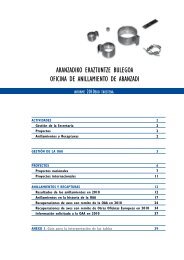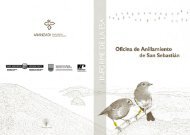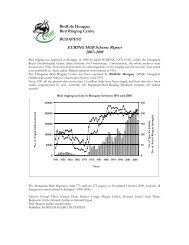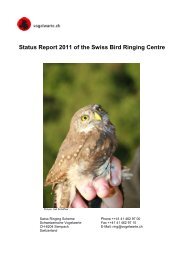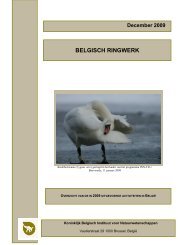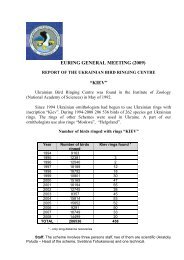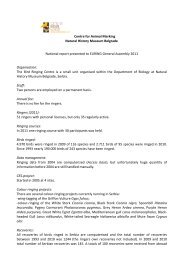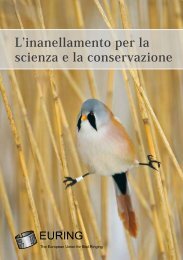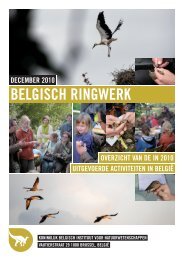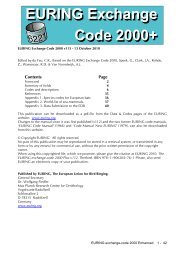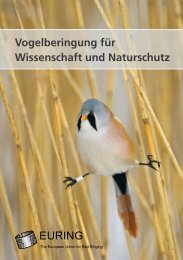The quantitative study of marked individuals in ecology, evolution ...
The quantitative study of marked individuals in ecology, evolution ...
The quantitative study of marked individuals in ecology, evolution ...
Create successful ePaper yourself
Turn your PDF publications into a flip-book with our unique Google optimized e-Paper software.
EURING 2003 Radolfzell<br />
Estimat<strong>in</strong>g albatross survival: deal<strong>in</strong>g with unobservable states<br />
Christ<strong>in</strong>e M. Hunter & Hal Caswell<br />
Survival estimation for <strong>in</strong>termittently-breed<strong>in</strong>g seabirds has previously been problematic<br />
because mark-recapture methods could not account for the unobservability <strong>of</strong><br />
non-breed<strong>in</strong>g adults. New methods us<strong>in</strong>g multi-state mark-recapture frameworks<br />
have been proposed by Fujiwara and Caswell (2002) and Kendall and Nichols (2002)<br />
to deal with unobservable states. <strong>The</strong> estimability <strong>of</strong> relevant parameters for these<br />
models requires either extra <strong>in</strong>formation (e.g. by use <strong>of</strong> Pollock’s robust design) or<br />
model constra<strong>in</strong>ts (e.g. time constancy) and has been <strong>in</strong>vestigated for a number <strong>of</strong><br />
simple model structures. Here we exam<strong>in</strong>e a series <strong>of</strong> more complicated models that<br />
differ <strong>in</strong> the distribution <strong>of</strong> <strong>in</strong>ter-breed<strong>in</strong>g <strong>in</strong>tervals and that dist<strong>in</strong>guish between successful<br />
and failed breeders. For each model we determ<strong>in</strong>e sets <strong>of</strong> assumptions sufficient<br />
to make the relevant parameters estimable. Estimability <strong>of</strong> parameters for these<br />
models is <strong>of</strong> <strong>in</strong>terest for many albatross species because the length <strong>of</strong> time they rema<strong>in</strong><br />
<strong>in</strong> the unobservable non-breed<strong>in</strong>g state depends on the outcome <strong>of</strong> the last<br />
breed<strong>in</strong>g attempt. We will identify a series <strong>of</strong> models applicable to estimat<strong>in</strong>g adult<br />
survival probability and <strong>in</strong>ter-breed<strong>in</strong>g <strong>in</strong>tervals for Wander<strong>in</strong>g Albatross (Diomedea<br />
exulans).<br />
Estimat<strong>in</strong>g the chick survival <strong>of</strong> colour r<strong>in</strong>ged gulls<br />
Risto Juvaste & Jari Valkama<br />
We present a method to estimate the chick survival <strong>of</strong> <strong>in</strong>dividually colour r<strong>in</strong>ged gulls.<br />
It is based on large scale colour r<strong>in</strong>g<strong>in</strong>g <strong>of</strong> Herr<strong>in</strong>g Gulls (Larus argentatus) (HG) and<br />
Lesser Black-backed Gulls (Larus fuscus) (LBBG) <strong>in</strong> F<strong>in</strong>land dur<strong>in</strong>g 1993-2000. Altogether<br />
7,636 chicks <strong>of</strong> Herr<strong>in</strong>g Gulls and 6,045 chicks <strong>of</strong> Lesser Black-backed Gulls<br />
were r<strong>in</strong>ged with <strong>in</strong>dividually coded colour r<strong>in</strong>gs (cr). By 14 February 2003, there were<br />
42,646 sight<strong>in</strong>gs <strong>of</strong> 4,342 HG <strong><strong>in</strong>dividuals</strong> (57%) and 21,827 sight<strong>in</strong>gs <strong>of</strong> 1,669 LBBG<br />
<strong><strong>in</strong>dividuals</strong> (27%) <strong>in</strong> the database <strong>of</strong> Hels<strong>in</strong>ki R<strong>in</strong>g<strong>in</strong>g Centre. Because most <strong>of</strong> the<br />
birds were aged dur<strong>in</strong>g r<strong>in</strong>g<strong>in</strong>g by measur<strong>in</strong>g the w<strong>in</strong>g length, the estimate for survival<br />
after r<strong>in</strong>g<strong>in</strong>g can be calculated from classified EURING 2003 – Poster Session 8 percentages<br />
<strong>of</strong> total sight<strong>in</strong>gs. <strong>The</strong> method has been tested with HG and LBBG populations<br />
<strong>in</strong> F<strong>in</strong>land. It was found that due to the high percentage <strong>of</strong> cr-sight<strong>in</strong>gs, the survival<br />
<strong>of</strong> HG chicks can be estimated even <strong>in</strong> small populations. An example is a cohort<br />
<strong>of</strong> 178 chicks r<strong>in</strong>ged near Lappeenranta (SE F<strong>in</strong>land), w<strong>in</strong>gs 55 mm-335 mm,<br />
median 200 mm. Altogether there are 370 sight<strong>in</strong>gs <strong>of</strong> 72 <strong><strong>in</strong>dividuals</strong> from these birds.<br />
By simple analysis <strong>of</strong> cr-sight<strong>in</strong>gs based on l<strong>in</strong>ear regression we estimated that about<br />
125 chicks fledged. <strong>The</strong> survival <strong>of</strong> chicks dur<strong>in</strong>g the last 3- 4 weeks before fledg<strong>in</strong>g<br />
was about 50%. By use <strong>of</strong> population analysis (Popan5/Jolly- Seber/full/birth) <strong>of</strong> the<br />
sight<strong>in</strong>g data (57 sight<strong>in</strong>gs/37 gulls) from a nearby dump it was estimated that 104 <strong>of</strong><br />
the fledged birds (83%) came to the dump. Estimate is however rough. Based on the<br />
yearly sight<strong>in</strong>gs we estimate that 24 birds (SD=5.2) were still alive <strong>in</strong> the year 2001<br />
(Popan5/Jolly-Seber/dead only). In a similar analysis <strong>of</strong> LBBG-chicks r<strong>in</strong>ged at F<strong>in</strong>nish<br />
lakes dur<strong>in</strong>g years 1993-2000 (n=3,457) there was an unexpected decrease <strong>in</strong><br />
survival <strong>in</strong> the group <strong>of</strong> nearly fledged chicks. <strong>The</strong> average survival decreased nearly<br />
10% from the group 250-300 mm to the group 300-380 mm. <strong>The</strong> percentages <strong>of</strong><br />
sight<strong>in</strong>gs <strong>in</strong> these groups were 54% and 45% (χ2=5,9 df=1 P=0.015 n=940). <strong>The</strong> reason<br />
for this decrease, which is aga<strong>in</strong>st the expected trend and found <strong>in</strong> all year cohorts,<br />
will be studied by analys<strong>in</strong>g the sub-cohorts, us<strong>in</strong>g both resight<strong>in</strong>gs and recoveries<br />
<strong>of</strong> metal r<strong>in</strong>gs.<br />
49



